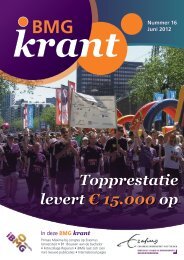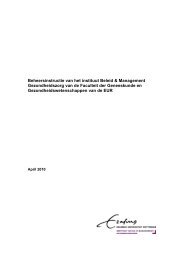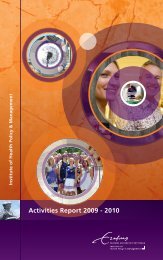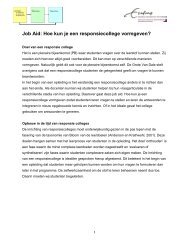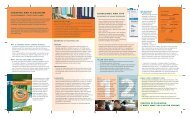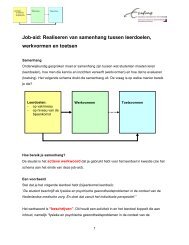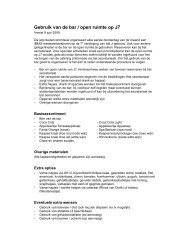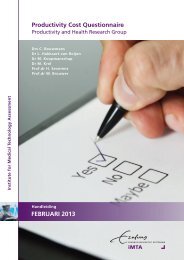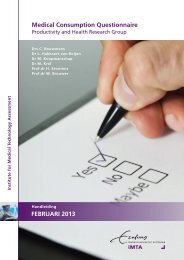150Summaryexpense of poor HRQoL in adulthood. Even though there is considerable sufferingin terms of both morbidity and mortality in the youngest group, the vast majorityof the patients ultimately enjoy healthy lives.We then examine the cost-effectiveness of neonatal extracorporeal membraneoxygenation (ECMO), an intervention the cost-effectiveness of which probably hasbeen questioned more than that of any other intervention in neonatal surgery(Chapter 5). A nation-wide population of 244 consecutive ECMO-treated newbornsborn between 1991 and 2001 with a diagnosis of CDH or meconium aspirationsyndrome (MAS) is compared to a historical control group of patients with CDH orMAS who would have been eligible for ECMO, were it available at the time. Meandirect medical costs for treatment including ECMO amount to € 38,553 perpatient, those for a patient with CDH (€ 50,792) being considerably higher thanthat for a patient with MAS (€ 29,472). Costs of treatment of patients in thecontrol group are comparatively low with an average of € 17,300. For CDHpatients, the survival rate is 0.04 without ECMO and 0.52 with ECMO. For MASpatients, survival without ECMO is 0.50, as compared to 0.94 in the ECMO era.Costs per additional survivor are € 78,455, or € 3,153 per life-year gained, in thepatients with CDH. For the patients with MAS, costs per additional survivor arecalculated at € 17,287, or € 697 per life-year gained. These findings indicate thatECMO improves survival in selected severely ill newborns suffering from CDH orMAS, and that it does so at reasonable cost.Chapter 6 goes on to consider the position of the parents of children who asnewborns underwent treatment for ARM or CDH. It is investigated what it takes tocare for these children (aged 1–11 years) and whether caregiving has an effecton the parents' HRQoL, encompassing physical, mental, and social domains.Approximately one third of the parents indicates that their child demands aboveaveragecare. They mention activities such as giving enemas and changingdiapers (ARM patients), or giving extra attention and administering medication(CDH patients). Relatively small shares of the parents have to forgo paid work orunpaid activities. Using the EQ-5D, the parents' HRQoL is found to be relativelylow compared with population statistics, especially in the parents of children withARM and in mothers. Interestingly, on average the parents consider that theirHRQoL would not be substantially better when someone else would take overtheir caregiving activities.Chapter 7 returns to the issue of the relevance of cost-effectiveness analyses inneonatal surgery, already touched upon in Chapter 1. It is argued that pediatricsurgeons are in a position to ethically accept rationing policies. Moreover,examining the state of the art in this area, it is found that the number ofpublished cost-effectiveness studies in the field of neonatal surgery is still small.A literature review over the period 1999 through 2005 identifies no more than 11relevant studies. Then, we generate insights into how cost-effectiveness interactswith other relevant determinants of how much priority should be given to
Summary 151neonatal surgery. It is shown that crucial ethical questions may arise, forexample, when deciding whether therapy should indeed be offered or perhapswithheld, which often involves life-and-death decisions. More from a policyperspective rather than the perspective of individual medical decision making,there are yet other factors that play a role in determining how much priorityneonatal surgery should be accorded in comparison and competition with otherareas of health care. Most crucial among these factors other than costeffectivenessseem arguments of equity, which reflect the feeling that the use ofcost-effectiveness analysis (in the sense of QALY maximization) may lead tounfair distribution of health care. Issues like these have received hardly anyattention so far in the literature on neonatal surgery. Nevertheless, given theirhigh impact, it would be of interest to analyze how equity considerations wouldwork out for the case of neonatal surgery, or, in other words, whether or not theyadd weight to the outcomes of cost-effectiveness analyses of neonatal surgery.Chapter 7 demonstrates that—although it is far from a settled issue how exactlyto consider equity when prioritizing health care programs for resource allocation—one of the equity dimensions that seem not to be sufficiently accounted for incost-effectiveness analyses, is the age of the patient. Most studies consulting thepublic presented evidence that a life saved, QALYs gained, or a year of perfect lifeare valued more when they occur to the young than to the old. Yet, while theyoung are generally preferred over the older, newborns are sometimes not givenpriority over slightly older children. It is concluded that, because many equityapproaches require that high priority be given to treating the young or those withthe most severe diseases, QALYs gained in newborns suffering from lifethreateninganomalies have a relatively high value.Finally, Chapter 8 draws together the results presented in the various chapters. Itstarts with this thesis' main conclusion that neonatal surgery is costly, but worththe expense. Yet, the results can be viewed from different perspectives, with eachperspective being useful for different audiences with different needs.Consequently, the reader is invited on an imaginary tour, which aims at looking atthis thesis' results from the perspectives of, respectively, the child and his or herparents, the pediatric specialist, society and its agents (the decision makers), andthe health economics researcher. It appears that, from each of theseperspectives, somewhat different aspects of the results may attract attention.Still, the results are firmly in favor of neonatal surgery, and not merely a matterof perspective. To sum up: this thesis approaches the question of the balancebetween the costs and effects of neonatal surgery and that of the balancebetween the cost-effectiveness argument and other arguments in health careallocation debates—a matter of balance indeed. The results reveal that neonatalsurgery yields good cost-effectiveness. However, this conclusion should betempered with a fourfold caveat. First, the favorable cost-effectiveness may notbe true in each and every case: the good results may not be valid in theexceptional cases of patients born with severe multiple anomalies. Second,further advancements in the care of patients with ARM or CDH remain wanted:
- Page 3:
COST-EFFECTIVENESS OF NEONATAL SURG
- Page 6 and 7:
DOCTORAL COMMITTEEPromotors:Prof.dr
- Page 9 and 10:
PUBLICATIONSChapters 2 to 7 are bas
- Page 11:
6ChapterINFORMAL CARE FOR CHILDREN
- Page 14 and 15:
2Chapter 11.1 BACKGROUND AND MOTIVA
- Page 16 and 17:
4Chapter 1provides a good overview
- Page 18 and 19:
6Chapter 1disability, and death of
- Page 21:
Introduction 9particular equity pri
- Page 25 and 26:
Introduction 1320. Oostenbrink JB,
- Page 27 and 28:
Introduction 1554. Heyman MB, Harma
- Page 29 and 30:
THE COST-EFFECTIVENESS OFTREATMENT
- Page 31:
Cost-Effectiveness of Treatment for
- Page 35 and 36:
Cost-Effectiveness of Treatment for
- Page 37 and 38:
Cost-Effectiveness of Treatment for
- Page 39 and 40:
Cost-Effectiveness of Treatment for
- Page 41 and 42:
Cost-Effectiveness of Treatment for
- Page 43 and 44:
Cost-Effectiveness of Treatment for
- Page 45:
Cost-Effectiveness of Treatment for
- Page 48 and 49:
36Chapter 3ABSTRACTBackground/Purpo
- Page 50 and 51:
38Chapter 33.2 MATERIALS AND METHOD
- Page 52 and 53:
40Chapter 3child's date of birth) a
- Page 54 and 55:
42Chapter 3diaphragm was closed (Ta
- Page 56 and 57:
44Chapter 3Total costs of treatment
- Page 58 and 59:
46Chapter 3Regarding the treatment
- Page 60 and 61:
48Chapter 3REFERENCES1. Stolk EA, P
- Page 62 and 63:
50Chapter 332. Jaillard S, Pierrat
- Page 64 and 65:
52Chapter 4ABSTRACTAims:To examine
- Page 66 and 67:
54Chapter 4Outcome measuresThe pati
- Page 68 and 69:
56Chapter 4Clearly, the symptoms st
- Page 70 and 71:
58Chapter 4The respondents did not
- Page 72 and 73:
60Chapter 4Table 4.4TAIQOL Scores o
- Page 74 and 75:
62Chapter 44.4 DISCUSSIONIn this pa
- Page 76 and 77:
64Chapter 4ACKNOWLEDGMENTSWe are in
- Page 78 and 79:
66Chapter 418. Coons SJ, Rao S, Kei
- Page 80 and 81:
68Chapter 5ABSTRACTObjective:Extrac
- Page 82 and 83:
70Chapter 5treatment. 26,27 Finally
- Page 84 and 85:
72Chapter 5CostsOnly direct costs w
- Page 86 and 87:
74Chapter 5summarized in Table 5.2.
- Page 88 and 89:
76Chapter 5Table 5.3 Direct Medical
- Page 90 and 91:
78Chapter 5Figure 5.3 illustrates o
- Page 92 and 93:
80Chapter 5severely ill newborns—
- Page 94 and 95:
82Chapter 5REFERENCES1. Bartlett RH
- Page 96 and 97:
84Chapter 533. Meinert CL: Extracor
- Page 98 and 99:
86Chapter 568. Hui TT, Danielson PD
- Page 100 and 101:
88Chapter 6ABSTRACTObjective:To inv
- Page 102 and 103:
90Chapter 6a rule. The health-relat
- Page 104 and 105:
92Chapter 6Regression analysis of h
- Page 106 and 107:
94Chapter 6that caregiving for thei
- Page 108 and 109:
96Chapter 6Table 6.5 CareQol Compar
- Page 110 and 111:
98Chapter 6children with a disabili
- Page 112 and 113: 100Chapter 6This study was of impor
- Page 114 and 115: 102Chapter 618. Poley MJ, Stolk EA,
- Page 116 and 117: 104Chapter 654. Boman KK, Viksten J
- Page 118 and 119: 106Chapter 7ABSTRACTMortality rates
- Page 120 and 121: 108Chapter 77.2 THE RELEVANCE OF CO
- Page 122 and 123: 110Chapter 7In the early 2000s, our
- Page 124 and 125: 112Chapter 7Table 7.1 Economic Eval
- Page 126 and 127: 114Chapter 7More from a policy pers
- Page 128 and 129: 116Chapter 7also expect that life-s
- Page 130 and 131: 118Chapter 7entirely justified, for
- Page 132 and 133: 120Chapter 723. Sydorak RM, Nijagal
- Page 134 and 135: 122Chapter 765. Glaser AW, Davies K
- Page 137 and 138: GENERAL DISCUSSION:A GUIDED TOURPRO
- Page 139 and 140: General Discussion: A Guided Tour P
- Page 141 and 142: General Discussion: A Guided Tour P
- Page 143 and 144: General Discussion: A Guided Tour P
- Page 145 and 146: General Discussion: A Guided Tour P
- Page 147 and 148: General Discussion: A Guided Tour P
- Page 149 and 150: General Discussion: A Guided Tour P
- Page 151: General Discussion: A Guided Tour P
- Page 154 and 155: 142GlossaryCharge (or: tariff)A pri
- Page 156 and 157: 144Glossaryefficient one. We are th
- Page 159 and 160: SUMMARY
- Page 161: Summary 149mortality. Finally, it i
- Page 165 and 166: SAMENVATTING
- Page 167 and 168: Samenvatting 155zoals directe niet-
- Page 169 and 170: Samenvatting 157Hoofdstuk 6 gaat ve
- Page 171: Samenvatting 159vereisen, waarvoor
- Page 174 and 175: 162AcknowledgmentsAlthough I am ind
- Page 176: About the AuthorBorn in De Meern (N





